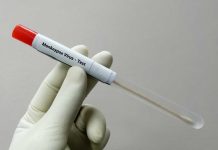A UK patient seems to have been cleared of the AIDS virus after he received a stem cell transplant from an HIV resistant donor – in only the second case of its kind, doctors report in Nature magazine.
Almost three years after receiving stem cells from a donor with a rare genetic mutation that resists HIV infection – and more than 18 months after coming off antiretroviral drugs – highly sensitive tests show no trace of the man’s previous HIV infection.
Stem cells as cure for AIDS/HIV
“There is no virus there that we can measure. We can’t detect anything,” said Ravindra Gupta, a professor and HIV biologist who co-led a team of doctors treating the man.
Although the patient has been in remission for 18 months, the authors of the British study published on Tuesday in the science journal Nature cautioned it was too early to say he had been cured.
The man is being called “the London patient”, in part because his case is similar to the first known case of a functional cure of HIV – in an American man, Timothy Brown, who became known as the Berlin patient when he underwent similar treatment in Germany in 2007 which also cleared his HIV.
Brown, who had been living in Berlin, has since moved to the United States and, according to HIV experts, is still HIV-free.
The Berlin patient’s disease was sent into permanent remission using treatment described as aggressive and toxic. Numerous attempts to replicate the procedure have not been successful until now, with the “London patient”.
The male London patient, who has not been named, was diagnosed with HIV in 2003 and advanced Hodgkin’s lymphoma in 2012.
He had chemotherapy to treat the Hodgkin’s cancer and, in addition, stem cells were implanted into the patient from a donor resistant to HIV, leading to both his cancer and HIV going into remission.
Researchers from University College London, Imperial College London, Cambridge and Oxford Universities were all involved in the case.
Is this new hope for curing AIDS?HIV?
Although the finding is exciting, it is not offering up a new treatment for the millions of people around the world living with HIV.
The aggressive therapy was primarily used to treat the patient’s cancer, not his HIV.
Current HIV therapies are really effective, meaning people with the virus can live long and healthy lives.
But the reason this case is so significant is that it could help experts who are looking for new ways to tackle HIV and achieve a cure.
Understanding how the body can naturally resist the infection does offer up hope of this, even if it is still a long way off.
Prof Eduardo Olavarria, also involved in the research, from Imperial College London, said the success of stem cell transplantation offered hope that new strategies could be developed to tackle the virus.
But he added: “The treatment is not appropriate as a standard HIV treatment because of the toxicity of chemotherapy, which in this case was required to treat the lymphoma.”
Moreso, even though the transplant went smoothly there were some side-effects, including the patient suffering a period of graft versus host disease – a condition in which donor immune cells attack the recipient’s immune cells.
Most experts have said it is inconceivable such treatments could be used to cure all patients. The procedure is expensive, complex and risky.
To do this in others, exact match donors would have to be found in the tiny proportion of people — most of them of northern European descent — who have the CCR5 mutation that makes them resistant to the virus.
Some 37 million people worldwide are currently infected with HIV and the AIDS pandemic has killed around 35 million people worldwide since it began in the 1980s. Scientific research into the complex virus has in recent years led to the development of drug combinations that can keep it at bay in most patients.




